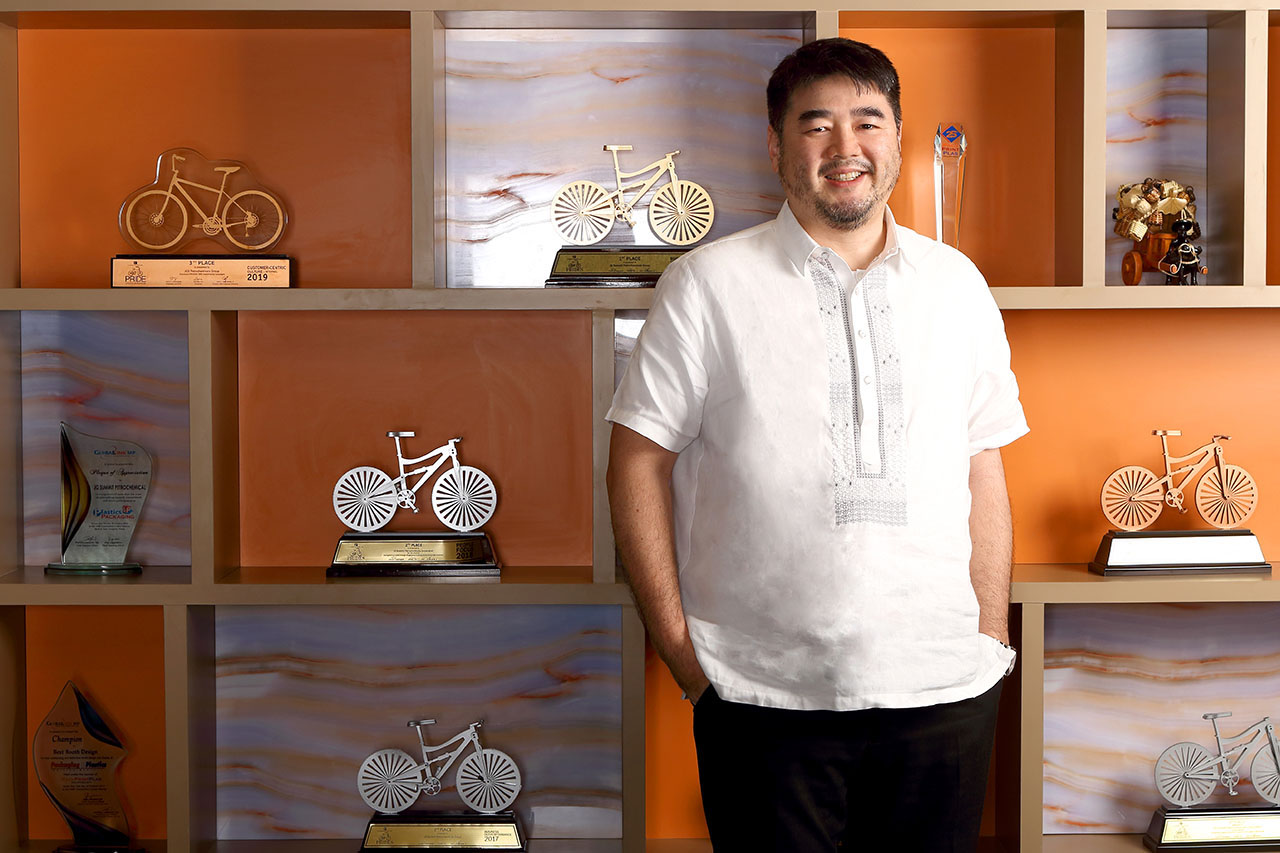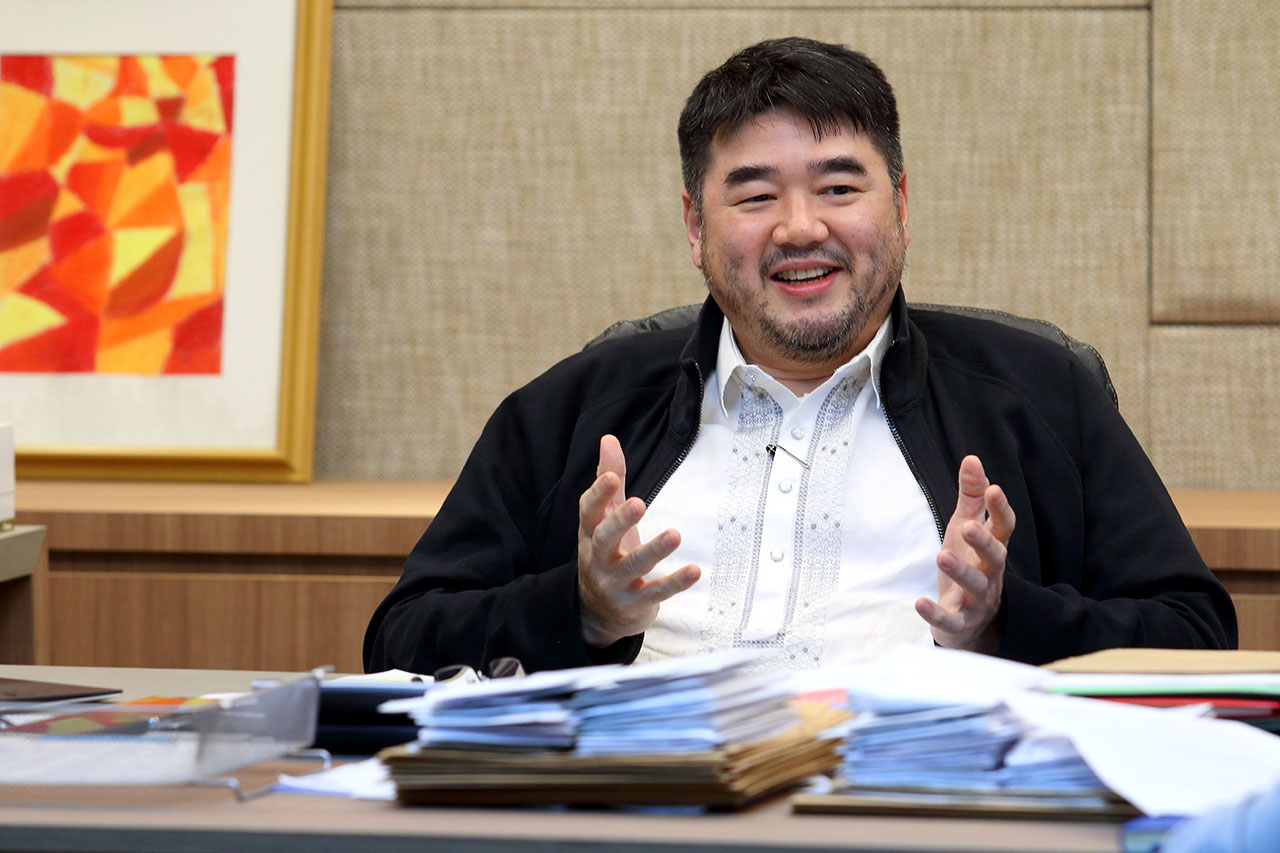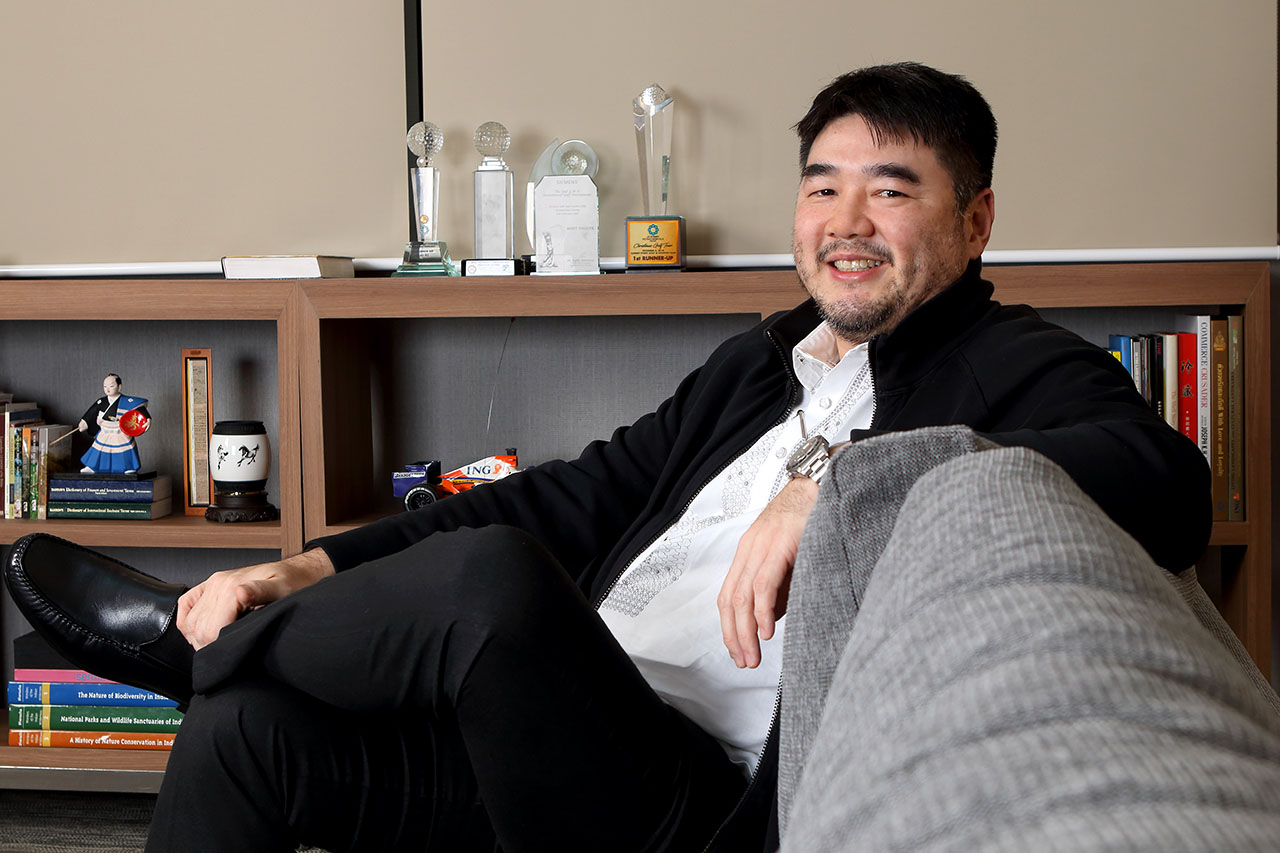Few Filipinos would give it a second thought, but a great number of the objects they interact with on a daily basis owe their existence to the petrochemicals industry. This fascinating bit of information we learn from Patrick Henry C. Go, the 49-year-old president and CEO of JG Summit Petrochemicals Group (JGSPG), as we meet at his company’s headquarters on a rainy afternoon.
He’s already got us convinced, but he points out a few concrete examples for emphasis—“The clothes you’re wearing—if they have polyester, that’s something the petrochemical industry produces. The rubber in the shoes you wear can be made from the raw materials that we make. That chair you’re sitting on, the pen you’re using, and maybe 40-50% of your phone has components made from petrochemicals.”
As Patrick sees it, the petrochemicals industry is a “basic” industry. He doesn’t mean that it is simple, but because of its importance in manufacturing many of the things we need and use daily, petrochemicals are considered a building block, a foundation, of industry. “Petrochemicals are found in practically everything that is manufactured, but very few people realize that. I think we owe it to the vision and the foresight of Mr. John, to understand that it was necessary to build the petrochemicals industry in our country.”

A ROCKY START
The JG Summit Petrochemicals Group (JGSPG) is composed of two main companies: JG Summit Petrochemical Corporation (JGSPC), incorporated in 1994, and JG Summit Olefins Corporation (JGSOC), incorporated in 2008. Today, JGSPG brings in substantial revenue for its parent conglomerate, generating Php42.4 billion in total sales in 2018. Despite business conditions being less than favorable, sales revenue was still higher than 2017’s figure of Php41.4 billion.
Things weren’t always rosy for the company, particularly at the start. As Patrick recalls, many people weren’t convinced of the viability of a petrochemicals plant when John L. Gokongwei Jr., the late founder and chairman emeritus of JG Summit Holdings, Inc. (JGSHI), was dreaming big in the early 1990s. As it turned out, aside from the potential profit a petrochemicals plant could bring, Mr. John was more interested in what having a domestic petrochemicals industry could do for the nation.
Construction of the JGSPC polymers plant, the conglomerate’s first petrochemicals business to be put up, began in 1995. Initially with a rated capacity of 200 kilotons per annum (kTA) for polyethylene (PE) and 180 kTA for polypropylene (PP), commercial operations of JGSPC began in March 1998.
Under Mr. John’s original vision, the construction of the country’s first naphtha cracking plant should have commenced soon after the polymer plants were completed. But due to the headwinds brought about by the Asian financial crisis in the late 1990s, the plan, which would allow greater vertical integration within the company, was put on hold.
The plans were derailed a second time in the mid to late 2000s, as world markets reeled from the near collapse of the American financial industry. But at the start of this decade, Patrick remembers that Mr. John decided to just go for it. “Go ahead and build it, he said. We just had to make sure that the conglomerate’s balance sheet was stronger before we started to build it, so it wasn’t a haphazard decision.”
JGSOC’s naphtha cracker plant, which initially had a rated capacity of 320 kTA for ethylene and 190 kTA for propylene, was constructed from 2011 to 2014, almost simultaneously with expansion of JGSPC’s PE and PP plants in 2012 to 2014. In 2014, the polymer plants commenced operating with increased production capacities of 320 kTA for PE and 190 kTA for PP.
IT’S ALL ABOUT CHEMISTRY
Patrick readily agrees with our assessment that out of all the industries the JG Summit conglomerate is involved in, whether food, retail, banking, real estate, or air transportation, the petrochemicals business is perhaps the least understood by the common man. He takes it even further: “It’s not just misunderstood by the common person, it's also misunderstood by most businessmen!”
Put in the simplest terms, petrochemicals are composed primarily of two elements, carbon (chemical symbol: C) and hydrogen (H), appearing in different forms or chemical bonds, known as hydrocarbons. According to Patrick, the company’s primary product, ethylene, is “just two carbon atoms and four hydrogen atoms. It’s literally C2H4 right? So, our base materials are two carbon atoms for ethylene, and three carbon atoms for propylene. It doesn't get more basic than that. From there, we can expand to polyethylene, polypropylene, different thermoplastics. We're going to other petrochemicals like butadiene (C4H6), benzene (C6H6), toluene (C7H8), mixed xylenes (C8H10) and C9+ aromatics. They may sound very complicated, but they are very essential chemicals that you need to start off to produce many of the things we use every day.”
Ethylene is the most widely produced organic compound in the world, usually produced through naphtha cracking, the method employed by JGSOC. (Trivia: Olefins are a group of petrochemicals derived from crude oil and/or natural gas. When processed, olefins, also known as alkenes, become polyolefins or polymers, having varying properties and uses.)
Before JGSOC set up its naphtha cracker, JGSPC imported its ethylene and propylene requirements which are used in the production of PE and PP, respectively. PE is the world’s most widely used polymer. It is used to make packaging materials such as films, bottles and caps, as well as durable items such as ropes, industrial pipes, pallets and crates.
PP, JGSPC’s other core product, is made into microwaveable food containers, plumbing pipes, furniture, sacks, stationery, toys and much, much more.
Under the brand name EVALENE®, JGSPC manufactures High Density Polyethylene (HDPE), Linear Low Density Polyethylene (LLDPE), Homopolymer Polypropylene (PP-H) and Random Copolymer Polypropylene (PP-R) resins.
The naphtha cracker plant and the polymer plants are housed in a fully integrated, 250-hectare world-class manufacturing complex in Batangas.
Currently, JGSPG is undergoing another expansion, with 2020 as the targeted completion date. Upon completion, the naphtha cracker will have a rated capacity of 480 kTA for ethylene and 240 kTA for propylene; the polypropylene plant will also increase production to 300 kTA, while a new Bimodal PE Plant will see addition of 250 kTA new capacity, bringing together JGSPC’s total PE capacity to 570 kTA.
Patrick says the second expansion became necessary because the plants have already been running at close to full capacity (around 97% to 98%, by his estimate), while demand and further potential for growth have been strong. If all goes well, revenues are expected to be in the region of Php60 billion to Php70 billion a year.

WHAT IT TAKES
When you’re born into the family behind one of the largest family-run conglomerates in the Philippines, joining one of its many companies is almost certainly in your future. This, however, was something that Patrick didn’t realize until he was about to graduate from Ateneo de Manila University, where he studied management. “It's a funny story. When I was still studying in Ateneo, I told my Dad I was being invited for interviews with P&G and Unilever. What he said was, ‘No, you're working for us.’”
Right after Patrick’s graduation in 1991, he was told to report to his uncle, JGSHI Chairman James L. Go, who was then in charge of Litton Mills, Inc., a textile company that was owned by the family. Like his cousins in the clan’s second generation who had started working for the family, he didn’t get any preferential treatment. Patrick started as a salesman, then moved to operations, and then took charge of the knitting side of the business. In Litton Mills, he gained the know-how, discipline, and work ethic needed to run a business—all useful now that he’s in charge of the group’s petrochemical business.
Believe it or not, Patrick says the textile business was even more difficult to run than the chemicals business. “Textiles, if you follow the process from raw cotton to finished fabric, have a more complicated process. There are mechanical and chemical processes involved, and again, few people realize how much goes into producing the cloth and finish of denim jeans or knitted fabric.”
He adds, “The discipline that you need to produce a piece of fabric is immense. You make a small mistake, they reject it. And you're talking about mistakes per hundred yards. If I remember correctly, if you have maybe two or three small knots in 100 yards, you are rejected. So it's a much more complicated process.”
After a few years in Litton Mills, he was called into the office of his uncle, Mr. John. “He told me that there were three new businesses that the group wanted to enter into. He said it was air transportation, telecommunications, and petrochemicals. At the time, I was thinking airlines would be a very difficult business since you had Philippine Airlines and all these international airlines competing against you. Then with Digitel, I saw the headwinds to be up against PLDT and Globe. With the petrochemicals industry, I said, here I am going to be alone. So this was going to be easy. But no. Among the three, it may have been the most difficult [to get off the ground].”
Similar to his experience at Litton Mills, Patrick learned about the industry as he flitted from one department to the next, gaining a valuable 360-view of the business. He also attended the General Manager Program of Harvard Business School in the U.S. before coming back to report directly to Wilfredo Paras, the JGSPC COO at the time. “I stayed with operations for a few months, maybe five or six months, then I handled logistics. I also handled procurement. Then I handled olefins trading and sales for a while. So I basically did the rounds,” says Patrick. When asked what his first title in the company was, he jokes, “I was the assistant of everybody!”
MODERN DAY CHALLENGES
Even though it is technically a petrochemicals-producing group, due to its being a source of materials for the plastics industry, JGSPG often has to deal with issues involving plastic waste. While some sectors are calling for a ban on plastics, Patrick says this isn’t the right approach. “Personally, I feel the efforts are wasted on trying to stop people from using plastic, as opposed to trying to find a way to recycle it.”
He continues, “I believe that the scientific community understands that plastics is actually a better material to use compared to paper, or glass, or metal. I think the effort to completely stop using plastic will create more problems than it solves, especially with the drive to reduce carbon emissions. Replacing plastics with alternative materials will consume more resources and will have worse environmental impacts. You're demonizing plastics, but I think the real issue is finding a way to close the loop, trying to find a way to recycle it back into the system.”
A good example of this approach is Japan, the second-highest consumer of plastic per capita, second only to the United States. There, the officially cited figure for end of life plastic recycling is 84%. The figure includes thermal recycling, where plastics are incinerated to produce energy. For PET bottles, Japan’s recycling rate is 84.8%, among the highest in the world.
“It’s a fact that the Philippines is one of the biggest polluters or creators of ocean waste. But if you take a look at the Philippines, as consumers of plastic we’re actually just one-tenth per capita against the Japanese or the Koreans, but they're not on the list.”
So, according to Patrick, efforts should be made to bring the Filipino on the same level as developed countries in terms of responsible use and disposal of plastic. “I think that we have to take a look at their models find out how they do it, how they educate the people, how they manage their waste, and how they cycle it back into the system. I think that's something that we have to pick up and try to emulate.”
With sustainability being a key driver of the JG Summit conglomerate’s mission, JGSPG has increased its initiatives in this sector. It has started working with like-minded groups keen to find a solution to plastic pollution. “We're working on how we can increase awareness of disposal, recyclability, life cycle analysis for consumers, and then try to educate people as much as we can. We're working with the local community in Batangas as a jump-off point, to try to come up with sustainable and scalable recovery and recycling initiatives.”

2020 AND BEYOND
Patrick assumed the President and CEO role of JGSPG in 2018, while his cousin Lance Y. Gokongwei sits as the company chairman. When asked about his own management style, Patrick says it’s a balance between a democracy and an autocracy. “There's this saying that decision making has to be a democracy. You have to get as many opinions and hear as much information as you can. But once you've decided, it's an autocracy. You have to make sure that the vision is executed properly. So it's really a blend of both. The decision making has to be as open as possible, but I think once we decide how to execute, we have to be very strict and get things done. At the end of the day, if you don't deliver, you're in trouble.”
A typical working day entails reading 200 or so e-mails, meeting with different groups every thirty minutes to an hour, and ending the day at around 8:30 p.m. But if he has to attend dinner meetings or functions, that could easily stretch to midnight.
Patrick says he’s lucky that JGSPG is a relatively young company, and as such it wasn’t difficult to mold the company’s DNA, its character, culture, and values. “We were able to inject the culture that we want into it. People aren’t set in their ways, so we can still mold JGSPG into how we see what's necessary to thrive in the industry. We work very hard to make sure that the culture is there. Operational excellence is top of mind; so is safety and social responsibility. These are things that we continue to build on.”
As we watched Patrick pose for photographs in front of the company’s impressive awards cabinet, we just had to ask, what’s been his proudest moment? In all honesty, he says, the thought had never once crossed his mind. “I've never stopped to think about what the proudest moment is. I just keep grinding along. People stop me once in a while, to remind me that we've accomplished this, we’ve accomplished that. I always say, ‘But it's not over.’ It's still going on, right?”
There’s truth in that. Patrick will be turning 50 next year, so he’s looking forward to many more years of accomplishment. He jokes that we should ask him the question again, probably in 15 years, when he retires. But for now, “We're still building, we're still pushing forward. It's not that I haven't had any happy moments or satisfied moments. But to say that I've had the proudest moment, it's too early. I think we've accomplished a lot, but there's still a lot more to do.”
For more information on the JG Summit Petrochemicals Group, visit their headquarters at 9F-11F, Robinsons Cyberscape Gamma Building, Topaz and Ruby Roads, Ortigas Center, Brgy. San Antonio, Pasig City. You may reach them at (632) 8397-3200 and (632) 8230-5000, or visit jgspetrochem.com